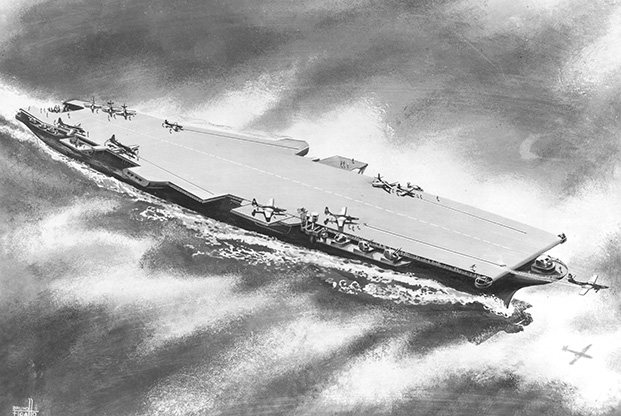
A 1948 illustration of a design concept for the proposed Navy aircraft carrier USS United States. The ship was designed to be a flush-deck supercarrier capable of launching large bombers armed with atomic weapons. Illustration: Bruno Figallo/USN
The spark that set off the Revolt of the Admirals in 1949 was the cancellation of the Navy’s supercarrier, the CVA-58 United States, within a few days of the laying of the keel.
The situation was already primed to ignite. The Navy in the postwar period had become apprehensive, then alarmed, about the impending unification of the services under a single Department of Defense. The rise of the Air Force was a challenge to naval aviation.
No foreign nation posed a threat to the United States at sea. With its traditional role thus diminished in importance, the Navy feared that it might be relegated to minor functions.
The nation’s strategic focus was on atomic weapons, which were in the domain of the Air Force. At the Key West conference in 1948, the mission of strategic air warfare had been assigned to the Air Force. The Navy was determined to roll back that decision and gain at least part of the atomic mission.
To do so, it needed a “supercarrier” that could launch large bombers. It also had to discredit the Air Force’s B-36 bomber, which was performing the mission the Navy wanted. Cancellation of the CVA-58 in April 1949 sent the Navy to battle stations.
The Revolt of the Admirals unfolded in stages over the next six months and revolved around a sweeping investigation by the House Armed Services Committee, whose chairman, Rep. Carl Vinson (D-Ga.), was the great patron and protector of the Navy.
The congressional inquiry was instigated by Rep. James Van Zandt (R-Pa.), a member of the HASC and a captain in the Navy Reserve. Van Zandt brandished an anonymous paper that supposedly exposed malfeasance in the B-36 procurement, including allegations of political and financial gain by Secretary of Defense Louis A. Johnson and Secretary of the Air Force Stuart Symington Jr.
It was not revealed until August that Van Zandt’s “unimpeachable evidence” consisted of a memo written by Cedric Worth, a civilian assistant to the Undersecretary of the Navy, and based purely on gossip and rumor. Worth had help in writing the memo from the deputy chief of Op-23, a special propaganda cell that had been set up by the Navy to work the strategic airpower issue.
Vinson soon acknowledged that the B-36 program was “clean as a hound’s tooth” but he allowed the investigation to continue. The Navy sent one admiral after another to testify. Their main message was that the Air Force had sold the nation a bill of goods on the B-36, and that the current strategy—which had been agreed upon by all of the service chiefs—was wrong.
Finally, Gen. Omar Bradley, the highly respected, even-handed Chairman of the Joint Chiefs of Staff, had heard as much as he could tolerate. In what the Washington Post called a “hide-searing statement” to the HASC, Bradley lambasted the dissident admirals as “fancy Dans who won’t hit the line with all they have on every play unless they call the signals.”
That effectively blew the Revolt of the Admirals out of the water. The chief of naval operations, Adm. Louis E. Denfeld, was relieved and replaced. Op-23 was shut down. Cedric Worth resigned.
Seventy years later, the Revolt of the Admirals lives on in naval tradition as a courageous lost cause, imperfect in some respects, but waged in a noble and justified purpose. The story from the historical record is at considerable variance with that.
_Read this story in our digital issue:
THE “ATOMIC CARRIER”
In February 1948, the Navy announced plans to build a “flush-deck” supercarrier. It would be 1,090 feet long, more than a tenth again larger than the Midway class carriers. An elevator would lower the bridge below the flight deck to allow easier operation of airplanes with a wide wingspan.
The manifest purpose was to establish a claim to the strategic bombing mission. The Navy regularly referred to the project as the “atomic carrier.”
In May 1948, the House Armed Services Committee gave unanimous backing for the Navy to “lay down” the supercarrier. Secretary of Defense James V. Forrestal and the Navy assured the HASC the project had been approved by all of the service chiefs. The Army and the Air Force said that this exaggerated the extent of their agreement.
Also in May, President Harry S. Truman announced his intention to hold the FY 1950 budget to $15 billion. The requirements calculated by the individual services came to $29 billion, almost twice the size of Truman’s limit.
The estimated cost of CVA-58 was $188 million, but the additional ships required to complete a supercarrier task force would raise it to $1.27 billion, an amount equal to more than eight percent of Truman’s total defense budget.
Bomber aircraft for the supercarrier—not yet developed and not available for another five years—would add $500 million to the cost. These aircraft would have the capability to deliver an atomic bomb but they would not match the range of Air Force bombers.
A contract for the CVA-58 was let in August 1948. Although not much was said about it, the Navy hoped eventually to have four carriers of that design.
The Air Force canceled six aircraft programs, 240 total aircraft in all, to help fund the B-36 program. Forrestal forwarded to the Bureau of the Budget a request for additional B-36s that would be equipped with four jet engines to augment the six piston engines and add to its capability.
Forrestal left office in March 1949 and was replaced by Louis A. Johnson, who asked the Joint Chiefs in April for a fresh appraisal of the supercarrier. The Navy was for it, but the Army and the Air Force were opposed. The majority opinion was that the supercarrier was too expensive for a limited strategic capability not part of a primary function assigned to the Navy.
The keel for the CVA-58 was formally laid April 18, but on April 23, Johnson issued orders for the program to be stopped “at once and at the least possible cost to the government.” The Secretary of the Navy, John L. Sullivan, who had not been consulted, resigned in protest and was replaced by Francis P. Matthews, whose main qualification was his willingness to cooperate with Johnson.
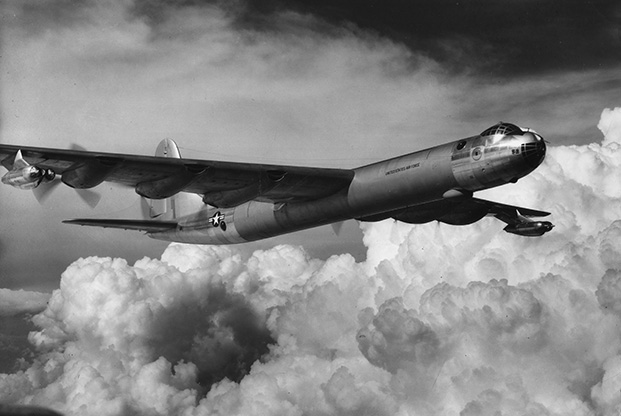
An Air Force Convair B-36 Peacemaker strategic bomber. It was performing the atomic mission the Navy wanted. Photo: Consolidated Vultee Aircraft Corp./AFA Library
THE NAVY STRIKES BACK
The Navy struck back on several fronts, making use of material produced by Op-23, a secretive “research and policy” unit created on the CNO’s staff the previous December and led by Capt. Arleigh A. Burke, a distinguished combat veteran of World War II.
Naval aviators clamored for a mock battle in which their F2H-1 Banshee fighter would attempt to intercept and attack a B-36. Van Zandt took the proposal to Vinson. The Joint Chiefs said the ability of the B-36 to evade interception and complete its mission depended on an entire process of factors and that a stand-alone set piece fighter demonstration was not a valid test. Vinson agreed with them and did not press the issue.
A recurring theme of the campaign was that an “atomic blitz” strategy gambled the future on the Air Force and the B-36. In fact, no such strategy existed and had never been proposed. In July, the Joint Chiefs issued a ringing endorsement of the current war plan. “The Joint Chiefs of Staff separately and jointly are of the firm opinion that the concept of strategic bombing and the extent of its employment as now planned are sound,” they said.
Both the effectiveness and the morality of strategic nuclear bombing role were regularly questioned. The most extreme claim was by Navy Cmdr. Eugene Tatom, head of research and development for aviation ordnance, who said, “you could stand in the open at one end of the north-south runway at the Washington National Airport with no more protection than the clothes you have on, and have an atom bomb explode at the other end of the runway without serious injury to you.”
Putting this into perspective, Bradley said that, “it has been the Navy’s continuous argument that they should be permitted to use the atomic bomb, both strategically and tactically. If it is really so ineffective as some would have you believe, I wonder why the Navy is so anxious to use it.”
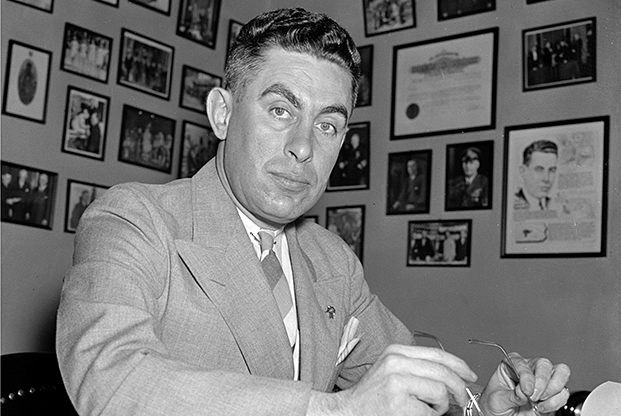
Rep. James Van Zandt (R-Pa.) Photo: Library of Congress
VAN ZANDT’S ALLEGATIONS
In the early summer of 1949, though, the main headlines were created by Van Zandt and his showy activities on Capitol Hill. He called for a congressional investigation into “ugly, disturbing reports” of wrongdoing in the B-36 program.
Van Zandt said he had “no personal knowledge” of the truth of these reports. However, he characterized various allegations as “well-founded” and based on “unimpeachable authority.” He also repeated them over and over on the floor of the House, where he could do so with immunity from a lawsuit.
Among the more spectacular accusations—and the actuality of the alleged events, soon verified by the Committee staff—were these:
- Floyd Odlum, the head of Consolidated Vultee, which produced the B-36 was supposedly a “heavy contributor” to President Truman’s election campaign in 1948, for which Secretary Johnson had been finance chairman. Odlum’s contribution was $3,000.
- Van Zandt said Forrestal had refused to approve the request for additional B-36s but that “a very short time” after he was sworn in to replace Forrestal, Johnson issued the order “in great haste.” In fact, Forrestal signed the approval two weeks before he left office. The order was in place when Johnson got there.
- According to Van Zandt, Symington was “a frequent weekend visitor at the Palm Springs, Calif., home of Mr. Odlum.” Symington had been there twice, once when his airplane diverted to land there because of weather—Odlum not being home at the time—and again for less than a full day in conjunction with a business meeting.
- A wartime defense contract with Emerson Electric Co., formerly headed by Symington, was said to have been renegotiated in Emerson’s favor in 1948 by Col. Frank Wolfe of Wright Field. Wolfe, then retired, supposedly lived in a luxurious Beverly Hills home. In fact, Symington had not been affiliated with Emerson since 1945. Wolfe had retired from the Air Force in 1944. In 1949, he lived in a rental apartment.
- Van Zandt said there was “a plan underway” for Symington to resign as Air Force Secretary as soon as the budget with more funds for the B-36 was approved and head a “huge aircraft combine” established by Odlum. In fact, there were no such plans, no such combine.
Symington challenged Van Zandt to repeat what he had said somewhere away from Capitol Hill where he would not be shielded by congressional immunity. Van Zandt declined.
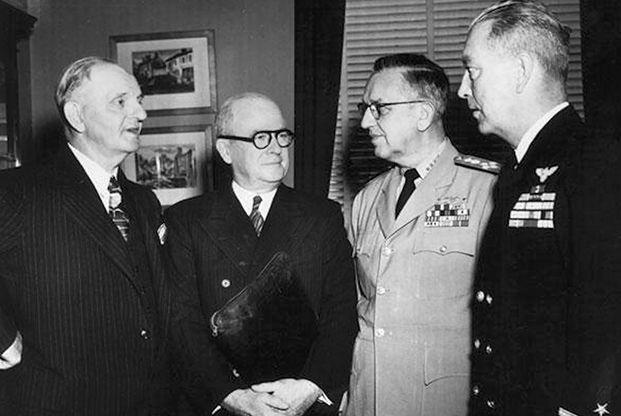
Rep. Carl Vinson (D-Ga.), (left), Secretary of the Navy Francis Matthews, Adm. Louis Denfeld, and Pacific Fleet Commander Arthur Radford in Washington, D.C., on Oct. 6, 1949. Photo: US Naval Institute
CONFESSION
When the hearings opened in August, it did not take long to dismiss the accusations. Vinson announced that there was “not one iota, not one scintilla, of evidence” of “collusion, fraud, corruption, influence, or favoritism” in the B-36 procurement.
Van Zandt’s sole source for his inflammatory statements was the paper, referred to in the press and elsewhere as the “anonymous memo.”
The Air Force knew where the paper came from—the Air Force Office of Special Investigations working with the FBI had tracked down the typewriter on which it was created—and told Vinson, who called Cedric Worth to the stand.
Worth, a former scriptwriter for the movies (“The Corpse That Knew Everybody” and “The Trail of the Serpent”) was an assistant to Undersecretary of the Navy Dan A. Kimball. Worth promptly admitted to Vinson that he had written the paper. “I made a great error and I regret it deeply,” he said.
A Navy court of inquiry subsequently established that the Op-23 deputy, Cmdr. Thomas M. Davies—noted for setting an aviation distance record in 1946—had helped Worth write the paper, drawing on “rank gossip” he had heard.
Davies said he had no idea Worth intended to circulate the paper, which according to one congressman was “peddled all over Capitol Hill” by an Active Duty naval officer.
“I made no charges or accusations,” Van Zandt said. “I simply repeated to the House the rumors that were all over Washington and were affecting service morale.”
Vinson rejected suggestions to terminate the inquiry, having been persuaded by the Navy that more needed to be heard on the underlying strategic issues.
Concurrently in August, Congress passed the National Security Act Amendment of 1949, completing the unification of the armed forces. The National Military Establishment was replaced by a much stronger Department of Defense. The individual service departments lost their Cabinet status. The position of Chairman of the Joint Chiefs of Staff, which had existed informally up to then, was created in law. The Army’s Omar Bradley was appointed the first CJCS.
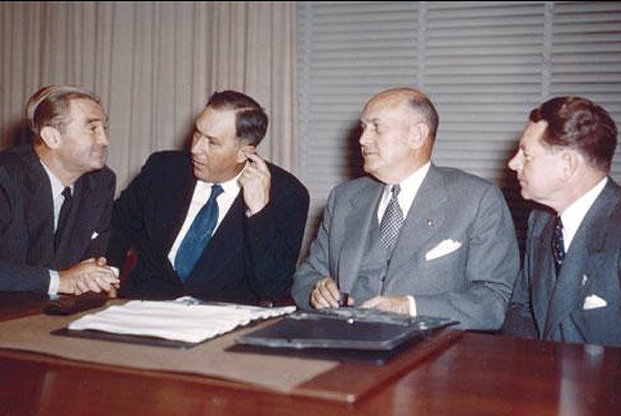
Air Force Secretary Stuart Symington, (left), speaks with Army Secretary Kenneth Royall Sr., Secretary of Defense Louis Johnson, and Secretary of the Navy John Sullivan in 1949. Photo: Naval History and Heritage Command
THE ADMIRALS RALLY
Navy Secretary Matthews implored the service to stick to its own issues in the hearing and not attack the Air Force. Matthews, however, had no credibility with the disgruntled admirals. “They kept the pot boiling with leaks or rebellious public statements, attacking Johnson’s budget cuts, the Air Force, the B-36, and the nuclear retaliatory strategy,” Bradley said.
The principal Navy spokesman was the colorful Adm. Arthur W. Radford, a naval aviator and commander of the US Pacific Fleet. He called the B-36 “a billion-dollar blunder,” a symbol of the “atomic blitz,” and “cheap and easy victory” through mass destruction of populations.
A parade of admirals, Active Duty and retired, took the stand to testify, but the headlines were grabbed by Capt. John G. Crommelin Jr., a naval aviator serving on the Joint Staff, who called a press conference to say the Navy was being systematically and intentionally destroyed.
Crommelin, who became a hero to many in the Navy, praised Cedric Worth for “the highest motives of patriotism and selflessness.” The legendary retired Adm. William F. Halsey Jr. said Crommelin “deserves the help and respect of all naval officers.”
CNO Denfeld, who through the summer had left it to others to carry the propaganda campaign, took the stand Oct. 13 to say, “There is a steady campaign to relegate the Navy to a convoy and antisubmarine service” and that “I do not believe that high-level strategic bombing will attain for us the objectives of a war.”
A week later, Bradley unloaded on the Navy and on the “fancy Dans who won’t hit the line” unless they could call the signals. “I believe that the public hearing of the grievances of a few officers who will not accept the decisions of the authorities established by law. . . have done infinite harm to our national defense, our position of leadership in world affairs, the position of our national policy, and the confidence of the people in their government.”
Coming as it did from Bradley, that was a fatal blow to the Revolt of the Admirals. Truman, acting on the advice of Secretary Matthews, relieved Denfeld as CNO on Oct. 27 and named Adm. Forrest Sherman, who had not taken part in the revolt, to replace him.
Tracing a news leak, a team from the Navy Inspector General’s office was dispatched for a no-notice inspection of the Op-23 files. Tipped off by an informant in the CNO’s office, Op-23 was able to pull the most sensitive papers out of the files and hide them in an office down the hall before the IG got there. On Nov. 3, Sherman disbanded Op-23 and reassigned Burke, Davies, and their colleagues to other duties.
OFF THEY GO …
Van Zandt was re-elected to Congress and served until 1963. He was an unsuccessful candidate for the Senate in 1962. He had retired as a rear admiral in the Navy Reserve in 1959.
Worth resigned and went back to writing movie scripts. In 1957, he produced a documentary, “Naked Africa.”
Crommelin continued to criticize Defense officials publicly, received a reprimand, and took early retirement when he was placed on indefinite furlough. He went home to Alabama where he ran for the US Senate and lost.
Radford followed Bradley as Chairman of the Joint Chiefs of Staff. He was a strong supporter of President Eisenhower’s New Look/Massive Retaliation strategy that increased the emphasis on nuclear weapons.
Burke, who had been redlined from the promotion list in December 1949, was reinstated and advanced to rear admiral by President Truman. With Radford as his sponsor, Burke became Chief of Naval Operations in 1955.
Davies retired as a rear admiral in 1973 after 40 years in the Navy.
The B-36 continued in effective service with Strategic Air Command until 1958.
The Navy went on to build big-deck carriers. The CVA-59 Forrestal in 1955 is regarded as the first supercarrier, but a “flush-deck” plan to lower the bridge with an elevator was scrapped. Instead, Forrestal had an angled flight deck with the “island” off to the side.
The carrier’s enduring claim to fame turned out to be its value in theater and tactical operations, not in launching long-range bombers. The Navy eventually gained a share of the nuclear mission when submarine-launched ballistic missiles took their place in the strategic triad alongside Air Force bombers and ICBMs.
_John T. Correll was the editor-in-chief of Air Force Magazine for 18 years and is now a contributor. His most recent article, “Intercepting the Bear,” appeared in the April / May issue.